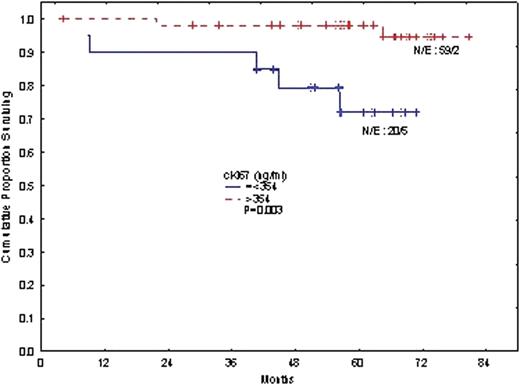Abstract
Abstract 4249
Ki-67 and caspase-3 are widely accepted as proliferation and apoptosis markers. We recently reported that Ki-67 can be detected as a circulating protein (cKi-67) in the plasma of patients with acute lymphoblastic leukemia (ALL), and that higher levels correlated with more aggressive disease. Here we investigated the levels of cKi-67 in patients with chronic myeloid leukemia (CML). We also evaluated the level of apoptosis in CML as determined by plasma levels of caspase-3 activity. The study included 127 CML patients: 81 in chronic phase and 46 in accelerated phase/blast crisis. cKi-67 levels were determined with an electro-chemiluminescence-based immunoassay. Apoptosis was determined by measuring caspase-3 activity (DEVD) in the plasma using a standard enzymatic fluorogenic assay. Patients with CML had significantly (P<0.0001) higher levels of cKi-67 and caspase-3 activity than normal control (n = 96). However, median (range) cKi-67 levels did not differ significantly between CML patients in chronic phase (523 [73-5857] ng/mL) and those in accelerated/blast crisis phase (710 [100-3530] ng/mL), nor did caspase-3 activity: 12.2 (6.1-29.1) pmol/min the chronic phase group and 12.2 (range=6.6-17.9) pmol/min in the accelerated/blast crisis group. The median of cKi-67 and caspase-3 in the healthy control group was 353.06 and 8.19, respectively and range 35.76-2830.65 ng/ul and 4.54-34.30 pmol/min, respectively. Neither cKi-67 level nor caspase-3 activity correlated with white cell count or blast count in the chronic phase or in the accelerated/blast crisis phase. There was no correlation between cKi-67 or caspase-3 levels and response to imatinib therapy. However, patients in the chronic phase with high levels of cKi-67 (>354 ng/mL) had significantly longer survival than did those with lower levels (P=0.003); cKi-67 levels were not associated with outcome in accelerated/blast phase CML. Caspase-3 activity did not correlate with outcome in chronic or accelerated/blast phase patients. In conclusion, cell proliferation and apoptosis as determined by plasma cKi-67 level and caspase-3 activity are elevated in CML, but higher levels of cKi-67 unexpectedly correlated with longer survival in chronic phase CML. Although the cause for this is unknown, it is possible that higher levels of cKi-67 reflect that more stem cells are in cell cycle, and this may make them more susceptible to therapy.
No relevant conflicts of interest to declare.
Author notes
Asterisk with author names denotes non-ASH members.


This feature is available to Subscribers Only
Sign In or Create an Account Close Modal